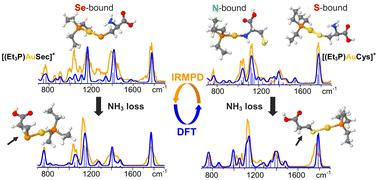当前位置:
X-MOL 学术
›
Inorg. Chem. Front.
›
论文详情
Our official English website, www.x-mol.net, welcomes your
feedback! (Note: you will need to create a separate account there.)
Vibrational analysis of auranofin complexes with cysteine and selenocysteine unveils distinct binding motifs and specific unimolecular reactivity
Inorganic Chemistry Frontiers ( IF 6.1 ) Pub Date : 2024-10-23 , DOI: 10.1039/d4qi02023e Roberto Paciotti, Davide Corinti, Cecilia Coletti, Nazzareno Re, Giel Berden, Jos Oomens, Simonetta Fornarini, Maria Elisa Crestoni
Inorganic Chemistry Frontiers ( IF 6.1 ) Pub Date : 2024-10-23 , DOI: 10.1039/d4qi02023e Roberto Paciotti, Davide Corinti, Cecilia Coletti, Nazzareno Re, Giel Berden, Jos Oomens, Simonetta Fornarini, Maria Elisa Crestoni

|
Auranofin (AF) is the most used gold(I)-containing drug, whose mechanism of action involves targeting sulfur and selenium-containing amino acids, including cysteine (Cys) and selenocysteine (Sec). These residues are present in the active sites of crucial proteins including thioredoxin reductase. Despite extensive exploration of AF-protein interactions over the years, experimental data at the molecular level are still limited. In this work, we studied the vibrational and structural features of solvent-free complexes obtained by the reaction of AF with Cys and Sec, [(Et3P)AuCys]+ and [(Et3P)AuSec]+ ions, respectively. Using tandem mass spectrometry and IR ion spectroscopy supported by density functional theory (DFT) calculations, we unveiled markedly different behaviors for the Cys and Sec bound complexes. In particular, our results indicate that, whereas the [(Et3P)AuSec]+ ions are mainly Se-bound, in agreement with the well-known affinity of Se for gold(I), the sampled [(Et3P)AuCys]+ ionic population is composed of both N- and S-bound isomers, with their ratio depending on the dielectric constant of the solvent used in the starting solution. Additionally, we found that the deamination process occurring in the gas-phase during collision-induced dissociation experiments significantly differ between the two complexes. This work's findings contribute to a deeper understanding of AF's reactivity with Cys and Sec-containing protein targets and highlight how the chemical environment may influence target selectivity of gold-containing drugs, which is crucial for their pharmacological activities.
中文翻译:

金诺芬与半胱氨酸和硒代半胱氨酸复合物的振动分析揭示了不同的结合基序和特异性单分子反应性
金诺芬 (AF) 是最常用的含金 () 药物,其作用机制涉及靶向含硫和含硒的氨基酸,包括半胱氨酸 (Cys) 和硒代半胱氨酸 (Sec)。这些残基存在于关键蛋白质的活性位点,包括硫氧还蛋白还原酶。尽管多年来对 AF-蛋白质相互作用进行了广泛的探索,但分子水平的实验数据仍然有限。在这项工作中,我们研究了 AF 与 Cys 和 Sec、[(Et3P)AuCys]+ 和 [(Et3P)AuSec]+ 离子反应获得的无溶剂复合物的振动和结构特征。使用密度泛函理论 (DFT) 计算支持的串联质谱和红外离子光谱,我们揭示了 Cys 和 Sec 结合复合物的明显不同行为。特别是,我们的结果表明,虽然 [(Et3P)AuSec]+ 离子主要是 Se 结合的,这与众所周知的 Se 对金的亲和力一致(),但采样的 [(Et3P)AuCys]+ 离子群由 N 和 S 结合的异构体组成,它们的比例取决于起始溶液中使用的溶剂的介电常数。此外,我们发现在碰撞诱导解离实验期间气相中发生的脱氨过程在两种复合物之间显着不同。 这项工作的结果有助于更深入地了解 AF 与含 Cys 和 Sec 的蛋白质靶点的反应性,并强调了化学环境如何影响含金药物的靶点选择性,这对它们的药理活性至关重要。
更新日期:2024-10-23
中文翻译:

金诺芬与半胱氨酸和硒代半胱氨酸复合物的振动分析揭示了不同的结合基序和特异性单分子反应性
金诺芬 (AF) 是最常用的含金 () 药物,其作用机制涉及靶向含硫和含硒的氨基酸,包括半胱氨酸 (Cys) 和硒代半胱氨酸 (Sec)。这些残基存在于关键蛋白质的活性位点,包括硫氧还蛋白还原酶。尽管多年来对 AF-蛋白质相互作用进行了广泛的探索,但分子水平的实验数据仍然有限。在这项工作中,我们研究了 AF 与 Cys 和 Sec、[(Et3P)AuCys]+ 和 [(Et3P)AuSec]+ 离子反应获得的无溶剂复合物的振动和结构特征。使用密度泛函理论 (DFT) 计算支持的串联质谱和红外离子光谱,我们揭示了 Cys 和 Sec 结合复合物的明显不同行为。特别是,我们的结果表明,虽然 [(Et3P)AuSec]+ 离子主要是 Se 结合的,这与众所周知的 Se 对金的亲和力一致(),但采样的 [(Et3P)AuCys]+ 离子群由 N 和 S 结合的异构体组成,它们的比例取决于起始溶液中使用的溶剂的介电常数。此外,我们发现在碰撞诱导解离实验期间气相中发生的脱氨过程在两种复合物之间显着不同。 这项工作的结果有助于更深入地了解 AF 与含 Cys 和 Sec 的蛋白质靶点的反应性,并强调了化学环境如何影响含金药物的靶点选择性,这对它们的药理活性至关重要。


















































 京公网安备 11010802027423号
京公网安备 11010802027423号